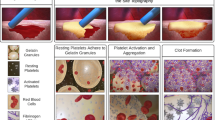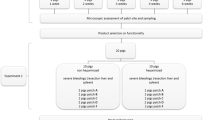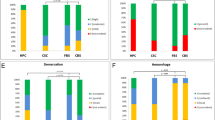Abstract
Introduction
The use of staplers in gastrointestinal surgery is widespread, especially in advanced laparoscopic procedures. Staple line reinforcement with a buttress reduces bleeding and associated complications through a combination of factors. The intrinsic hemostatic properties of buttress materials have not been examined. This study examined the intrinsic hemostatic properties of two different types of material used in buttressing in an accepted hemostasis model that does not involve stapling or its effects by compression.
Materials
An acellular collagen buttress (Veritas®) and a synthetic polymer buttress (Duet™) were compared to two commonly used hemostatic agents, Syvek® and Surgicel®, with gauze as control.
Methods
In a swine capsular stripping hemostasis model, a 1 × 1 cm section of spleen capsule was removed and used as a source of bleeding, with one patch of material tested per bleeding site. A total of 51 wounds were created in five pigs (each patch n = 10, control n = 11). Hemostatic efficacy was assessed by quantitating the number of applications and total time needed for bleeding to stop.
Results
The mean time needed for hemostasis for Syvek® and Veritas® patches was significantly less than gauze, Duet™ and Surgicel® (4.02, 4.51 vs. 8.97, 9.22, and 10.30 min respectively; p < 0.05). The Syvek® and Veritas® patches required significantly fewer applications than gauze, Duet™ and Surgicel® (1.7, 2.2 vs. 4.1, 4.6, and 4.9 respectively; p < 0.01).
Conclusions
The intrinsic hemostatic properties of different buttressing materials vary widely. In this study, a collagen buttress was significantly better at promoting hemostasis than the synthetic buttress material in a nonstapling model. This could be another factor to consider when choosing a buttress for staple line reinforcement.

Similar content being viewed by others
References
Angrisani L, Lorenzo M, Borrelli V, Ciannella M, Bassi UA, Scarano P (2004) The use of bovine pericardial strips on linear stapler to reduce extraluminal bleeding during laparoscopic gastric bypass: prospective randomized clinical trial. Obes Surg 14(9):1198–1202
Assalia A, Ueda K, Matteotti R, Cuenca-Abente F, Rogula T, Gagner M (2007) Staple-line reinforcement with bovine pericardium in laparoscopic sleeve gastrectomy: experimental comparative study in pigs. Obes Surg 17(2):222–228
Barnes MJ, Gordon JL, MacIntyre DE (1976) Platelet-aggregating activity of type I and type III collagens from human aorta and chicken skin. Biochem J 160(3):647–651
Chan MW, Schwaitzberg SD, Demcheva M, Vournakis J, Finkielsztein S, Connolly RJ (2000) Comparison of poly-N-acetyl glucosamine (P-GlcNAc) with absorbable collagen (Actifoam), and fibrin sealant (Bolheal) for achieving hemostasis in a swine model of splenic hemorrhage. J Trauma 48(3):454–457 discussion 457-458
Cole DJ, Connolly RJ, Chan MW, Schwaitzberg SD, Byrne TK, Adams DB, Baron PL, O’Brien PH, Metcalf JS, Demcheva M, Vournakis J (1999) A pilot study evaluating the efficacy of a fully acetylated poly-N-acetyl glucosamine membrane formulation as a topical hemostatic agent. Surgery 126(3):510–517
Consten EC, Gagner M, Pomp A, Inabnet WB (2004) Decreased bleeding after laparoscopic sleeve gastrectomy with or without duodenal switch for morbid obesity using a stapled buttressed absorbable polymer membrane. Obes Surg 14(10):1360–1366
Fischer MG (1976) Bleeding from stapler anastomosis. Am J Surg 131(6):745–747
Hait MR (1970) Microcrystalline collagen. A new hemostatic agent. Am J Surg 120(3):330
Hutter MM, Randall S, Khuri SF, Henderson WG, Abbott WM, Warshaw AL (2006) Laparoscopic versus open gastric bypass for morbid obesity: a multicenter, prospective, risk-adjusted analysis from the National Surgical Quality Improvement Program. Ann Surg 243(5):657–662 discussion 662-666
Letwin E, Williams HT (1967) Healing of intestinal anastomosis. Can J Surg 10(1):109–116
Lujan JA, Frutos MD, Hernandez Q, Liron R, Cuenca JR, Valero G, Parrilla P (2004) Laparoscopic versus open gastric bypass in the treatment of morbid obesity: a randomized prospective study. Ann Surg 239(4):433–437
Lustosa SA, Matos D, Atallah AN, Castro AA (2001) Stapled versus handsewn methods for colorectal anastomosis surgery. Cochrane Database Syst Rev (3):CD003144
Mehran A, Szomstein S, Zundel N, Rosenthal R (2003) Management of acute bleeding after laparoscopic Roux-en-Y gastric bypass. Obes Surg 13(6):842–847
Nguyen NT, Rivers R, Wolfe BM (2003) Early gastrointestinal hemorrhage after laparoscopic gastric bypass. Obes Surg 13(1):62–65
Prior JJ, Wallace DG, Harner A, Powers N (1999) A sprayable hemostat containing fibrillar collagen, bovine thrombin, and autologous plasma. Ann Thorac Surg 68(2):479–485
Ren CJ, Patterson E, Gagner M (2000) Early results of laparoscopic biliopancreatic diversion with duodenal switch: a case series of 40 consecutive patients. Obes Surg 10(6):514–523 discussion 524
Saber AA, Scharf KR, Turk AZ, Elgamal MH, Martinez RL (2008) Early experience with intraluminal reinforcement of stapled gastrojejunostomy during laparoscopic Roux-en-Y gastric bypass. Obes Surg 18(5):525–529
Schauer PR, Ikramuddin S, Gourash W, Ramanathan R, Luketich J (2000) Outcomes after laparoscopic Roux-en-Y gastric bypass for morbid obesity. Ann Surg 232(4):515–529
Schwaitzberg SD, Chan MW, Cole DJ, Read M, Nichols T, Bellinger D, Connolly RJ (2004) Comparison of poly-N-acetyl glucosamine with commercially available topical hemostats for achieving hemostasis in coagulopathic models of splenic hemorrhage. J Trauma 57(Suppl 1):S29–S32
Seyednejad H, Imani M, Jamieson T, Seifalian AM (2008) Topical haemostatic agents. Br J Surg 95(10):1197–1225
Shandall A, Lowndes R, Young HL (1985) Colonic anastomotic healing and oxygen tension. Br J Surg 72(8):606–609
Shikora SA, Kim JJ, Tarnoff ME (2008) Comparison of permanent and nonpermanent staple line buttressing materials for linear gastric staple lines during laparoscopic Roux-en-Y gastric bypass. Surg Obes Relat Dis 4(6):729–734
Suter M, Paroz A, Calmes JM, Giusti V (2006) European experience with laparoscopic Roux-en-Y gastric bypass in 466 obese patients. Br J Surg 93(6):726–732
Tuchmann A, Dinstl K, Strasser K, Armbruster C (1985) Stapling devices in gastrointestinal surgery. Int Surg 70(1):23–27
Wagner WR, Pachence JM, Ristich J, Johnson PC (1996) Comparative in vitro analysis of topical hemostatic agents. J Surg Res 66(2):100–108
Disclosures
David Spector and Scott Shikora have received grant support for research from Synovis Life Technologies. Scot Shikora is part of a scientific advisory board and a consultant for Synovis Life Technologies. Tracy Konobeck and Dan Mooradian work in the Research and Development Department of Synovis Life Technologies. Zvi Perry has no conflicts of interest or financial ties to disclose.
Author information
Authors and Affiliations
Corresponding author
Rights and permissions
About this article
Cite this article
Spector, D., Perry, Z., Konobeck, T. et al. Comparison of hemostatic properties between collagen and synthetic buttress materials used in staple line reinforcement in a swine splenic hemorrhage model. Surg Endosc 25, 1148–1152 (2011). https://doi.org/10.1007/s00464-010-1331-4
Received:
Accepted:
Published:
Issue Date:
DOI: https://doi.org/10.1007/s00464-010-1331-4




